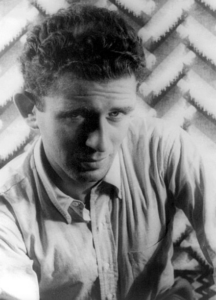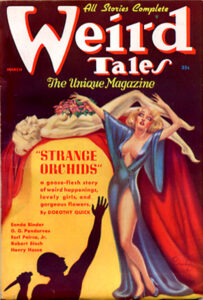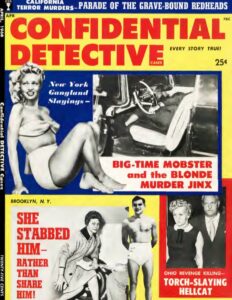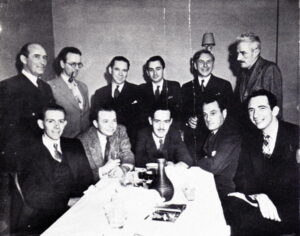
“It’s not a good idea to put your wife into a novel…not your latest wife, anyway.” – Norman Mailer
Have you ever used a real person as the basis for a character in one of your novels? Been tempted to? What’s the backstory on that?

by James Scott Bell
@jamesscottbell
 As you know, I’m a fan of the old pulp magazines. They sold like hotcakes to a reading public that wanted their stories fast and entertaining. The key to sales of these mags was, first, an attention-grabbing cover. Since men were the primary readers, tough guys and fetching femmes were prominently featured. The imaginative Weird Tales, for example, specialized in scantily-clad women from other worlds.
As you know, I’m a fan of the old pulp magazines. They sold like hotcakes to a reading public that wanted their stories fast and entertaining. The key to sales of these mags was, first, an attention-grabbing cover. Since men were the primary readers, tough guys and fetching femmes were prominently featured. The imaginative Weird Tales, for example, specialized in scantily-clad women from other worlds.
Then it was up to the story titles and/or author names to close the sale. An intriguing title like Murder in the Ring or a popular name like Gardner, Chandler, Hammett, or Ballard would incentivize the buyer to part with two bits.
In the 1950s, covers got steamier. A trendsetter in this regard was Confidential Detective. The stories inside, accompanied by photos, were nonfiction (“Every Story True!” the cover blared). But the selling principle was the same. Grab with a cover, entice with a title and a blurb.
 Check out this cover from April, 1960. Alluring blonde prominently featured. Titles appealing to our insatiable curiosity about the criminal mind, especially with a sex angle.
Check out this cover from April, 1960. Alluring blonde prominently featured. Titles appealing to our insatiable curiosity about the criminal mind, especially with a sex angle.
The table of contents for this issue had the following blurbs:
BIG-TIME MOBSTER AND THE BLONDE MURDER JINX
She was a gorgeous bundle of hard luck—especially to racket bosses and Murder, Inc. hoods. But Little Augie wasn’t scared—till the night her jinx worked on him.
SHE STABBED HIM—RATHER THAN SHARE HIM!
With a swift motion, she drove the knife into his chest—up to the handle. Then she yanked the phone from his hand and yelled to the blonde at the other end: “Listen to him moan…I killed him!”
BACK-DOOR LOVER’S DOUBLE-DEATH REVENGE!
Behind every blind in town, and in every bar—there were whispers about the judge’s pretty wife. Then, one night the gossip was confirmed—in bullets and in blood…
TORCH-SLAYING HELLCAT
The fire that ate her love rival’s body roared for hours, but it didn’t consume all the evidence of the blonde’s furious passions.
PARADE OF THE GRAVE-BOUND REDHEADS
One by one, Frankie promised his girls the moon—love, marriage…But when they tried to collect, he paid them off—in cold murder.
JEALOUS FURY KILLS THE NIGHT-CLUB HOSTESS
“Put down the gun,” she begged. “I’ll never, never look at another guy…”
“THE DAMES ALL DIE FOR ME!”
The startling story of a first-class heel who used lies, bigamy, even murder to keep his women in line.
There were marketing people for these mags whose main task was to come up with what I call “power blurbs.” What a job! Come into the office in Manhattan and hammer out a few headlines. Grab a three-martini lunch. Come back to the office, nap, write the subheads.
And it got me to thinking, what if I were tasked to come up with similar allurements for some famous novels? How would I entice the browser to make the purchase? Eschewing the martinis, I knocked out a few:
The Silence of the Lambs
“HE ATE A CENSUS TAKER FOR DINNER—AND I DON’T LIKE THE WAY HE’S LOOKING AT ME!”
The brilliant psychiatrist with a yen for human flesh tried to outfox a young FBI trainee who was haunted by dreams of slaughtered lambs. Was there any hope for this couple?
The Old Man and the Sea
MAN-EATING SHARKS SURROUNDED HIS BOAT—AND DEMANDED TO BE FED!
He was just a little old fisherman with the catch of a lifetime—but jaws of death weren’t going to let him keep it!
The Great Gatsby
OBSESSED WITH ANOTHER MAN’S WIFE!
“She’s mine, Old Sport,” he told his friend. “And I mean to get her back!”
1984
“THEY SAY HE’S MY BIG BROTHER, BUT HE WANTS TO MAKE ME HIS SLAVE!”
He thought two plus two made four—until they messed with his mind.
Then I gave it a whirl with one of my own:
Romeo’s Rules
THE BAD GUYS BET THEY COULD KILL HIM—SO HE MADE THEM PAY!
“I was tied up. My hands behind me. I was in a semi-fetal position on a hard floor. That’s when I got mad.”
It seems to me that writing out a power blurb can really help you nail the selling point of your novel. If you do this early in your writing it will keep you focused as you create your scenes. Or it can be used as a laser beam when it comes time to edit a first draft. Heck, you might even use it as the lead for your book description on Amazon. Why not? “WE WANT TO SELL BOOKS,” SAID THE AUTHORS GATHERED AT THE BAR. And they were willing to do just about anything to do it!
Anyway, it’s fun. Why don’t you try it? Give us a power blurb for a famous novel. Or one of your own if you like. Make us part with two bits!
by James Scott Bell
@jamesscottbell

Today’s first page comes to us, it appears, from across the pond. The author identifies it as “Comedic Noir.” Let’s have a look at it, and discuss:
The Bookshop
I step over a shard of a broken concrete paver, its exposed edge a looming obstacle in the fine drizzle.
A raincoat-clad woman is leaning in against the shop front window. Rain water runs in rivulets off her black mac, the gloss and her shape, has me thinking of a wet seal. Her hands cup her eyes and she peers into its shadowed recesses. Red ankle socks cut into her stout doughy legs. It’s mere idle curiosity I’m sure. After all, the advert, secured by a rusty drawing pin to the general dealer notice board, was curling and crisp with age. Nobody’s been interested in these premises for a while.
She startles at a squeal from the sole of my sneaker and jumps back guiltily.
‘Oh my goodness, where’d you pop up from? I didn’t hear you.’ Her voice is grumbly and hoarse, sort of Nina Simone.
‘Sorry, I didn’t mean to alarm you.’ I approach the door and fish the key out of my pocket.
‘Ah, you’re opening up. Great, I’d like a mosey inside. Any idea of the rental? I should’ve asked Daisy.’
‘I’m hoping to sign a lease on it.’ It comes out harsher than I’d intended, sort of snobby and possessive. I do know the monthly rental, but I don’t want to compete with anyone for occupancy. I unlock and push the door. It doesn’t budge. It’s wedged closed with months of accumulated dirt and rotten leaves. I scoop the slimy vegetation away with the toe of my shoe and push again.
‘Here, let me.’ She clutches the handle and puts her shoulder on the frame of the door giving a grunt and a heave. It swings open, taking her with it.
She stands inside, legs and arms akimbo, blocking my access. ‘Spiffy. Plenty of space. Ooh, I like the one raw brick wall, gives character. I can work with that.’
I could shove past her but she’s dripping water like a beached walrus. I clear my throat.
‘Oh sorry.’ She steps aside and makes her way to the right where there’s a wooden counter with pewter coloured cupboards. They contrast well with the red brick of wall.
A pungent mustiness of damp tickles my nose. I hear her opening and banging the doors but I’m drawn to the windows at the rear. They’re splattered with raindrops and the splotches of countless dead midges but when cleaned, they’ll give a great view of the village green. I can picture fellow bibliomaniacs curled in chunky armchairs, soaking up the view and the late afternoon sun.
She’s hollering to me. ‘Any idea about the wiring?’
Who is this woman?
JSB: Let’s mention the POV off the bat. Obviously it’s First Person Present. We recently discussed this, so I’m not going to go over the same ground. As long as the writer has considered the pros and cons, I don’t have a problem with the choice. I’ll only mention that for fans of classic noir it might be a slight speed bump.
Overall, the scene is mildly interesting. But we don’t want mild in an opening page. We want to be grabbed and pulled in. I’d love to see more conflict here—more attitude, more intensity. The narrator is passive. Maybe that’s intended at the start, but at least give him some feeling—annoyance, aggravation, mad because his wife left him—anything. (Note: We don’t know what sex the narrator is, and that’s a problem. I’ll assume for discussion purposes that it’s a man. But do something on this page to clue us in.)
You, dear author, have an obvious felicity with words. But felicity can get you into trouble if you don’t watch it. I’m going to be tough on you because I know you can write. So hang in there!
In Shakespeare’s play King John, Salisbury says:
To gild refined gold, to paint the lily…
Is wasteful and ridiculous excess.
Somehow that’s come down to us as “gild the lily,” probably because it sounds better (I don’t think Bill S. would mind). It means to dress up what is already beautiful, to add a layer that is not only unnecessary, but actually dilutes the intended effect.
This piece has several such instances. The good new is that there’s an easy fix. It’s called the delete key, and the benefits are immediate.
I step over a shard of a broken concrete paver, its exposed edge a looming obstacle in the fine drizzle.
We already know a shard is something broken. We know that if he steps over it, it has to be exposed. We also know that drizzle, by definition, is fine. All those adjectives are gilding the lily. They weigh the sentence down. That’s fatal, especially for noir. Here’s the rework: I step over a shard of concrete paver, its edge a looming obstacle in the drizzle.
Much stronger, but there’s still more work to do. I’m not enamored of looming obstacle. For one thing, it isn’t looming. It’s right there under his foot. Nor is it much of an obstacle if a guy can just step over it.
Here’s a radical idea: ditch the whole thing. This opening line doesn’t add anything to the scene to come. In good noir style, let’s start with the woman!
A raincoat-clad woman is leaning in against the shop front window. Rain water runs in rivulets off her black mac, the gloss and her shape, has me thinking of a wet seal.
We know that shop windows are in front. Cut front.
We know that rain is water. Cut water.
The second sentence is compound, and the second comma is misplaced.
The word leaning is also puzzling. You tell us in the next sentence that she’s peering. But leaning could mean resting her head on the glass because she’s tired, etc.
You can clear up everything this way: A raincoat-clad woman is peering through the shop window. Rain runs in rivulets off her black mac. The gloss and her shape has me thinking of a wet seal. Red ankle socks cut into her doughy legs.
You’ll notice I cut the word stout because that’s the same as doughy. Don’t gild the lily—or the legs!
It’s mere idle curiosity I’m sure.
Cut mere, for that is what idle curiosity is by definition. You also need a comma after curiosity. Or you could write, I’m sure it’s idle curiosity.
After all, the advert, secured by a rusty drawing pin to the general dealer notice board, was curling and crisp with age. Nobody’s been interested in these premises for a while.
A couple of things jolt me here. After all sounds like an expression directed to the reader, rather than the flow of narrative. Also, you lapse into past tense with was curling. And the two sentences seem on the wrong side of each other. I’d suggest: Nobody’s been interested in these premises for a while. The advert, secured by a rusty drawing pin to the general dealer notice board, is curling and crisp with age.
She startles at a squeal from the sole of my sneaker and jumps back guiltily.
Do we really need guiltily? How does he know it’s guilt and not just surprise? Anyway, any adverb here dilutes the strong picture of her jumping back. Let the action itself do the work.
‘Oh my goodness, where’d you pop up from? I didn’t hear you.’
You can gild dialogue, too! After her first statement we don’t need her to say I didn’t hear you. Plus, she just jumped back at his approach. We saw that she didn’t hear him.
Her voice is grumbly and hoarse
Grumbly and hoarse are virtually synonymous. Choose one.
sort of Nina Simone.
Okay, we have to talk about this. Normally, I’m okay with a few pop culture references, so long as they are easy to identify and help set the tone.
But how many current readers, unless they are jazz aficionados, know Nina Simone?
And when I think of her music I picture Nina at a piano singing deep and soulful blues in a smoky café. That is directly opposite the impression I get from a doughy-legged woman crying, “Oh my goodness, where’d you pop up from?”
In short, this is an old and obscure reference, and works against the comic-noir tone you’re trying to create.
‘Sorry, I didn’t mean to alarm you.’ I approach the door and fish the key out of my pocket.
Give the guy some attitude. Create tension. E.g., ‘You mind telling me what you want here?’
‘Ah, you’re opening up. Great, I’d like a mosey inside. Any idea of the rental? I should’ve asked Daisy.’
Ack! He’s going toward the door with a key. We don’t need her to tell him (or us) ‘Ah, you’re opening up.’
‘I’m hoping to sign a lease on it.’ It comes out harsher than I’d intended, sort of snobby and possessive.
Again, too passive. Let’s have some attitude, e.g., ‘I’m going to sign a lease, if that’s what you’re thinking.’ Then you wouldn’t need to gild it by telling us it’s snobby and possessive.
I unlock and push the door. It doesn’t budge. It’s wedged closed with months of accumulated dirt and rotten leaves.
I’m unsure of the physics here. Are “months” of dirt and leaves enough to wedge a door closed? And even so, if they’re on the outside and the narrator is pushing inward, where is the wedge?
‘Here, let me.’ She clutches the handle and puts her shoulder on the frame of the door giving a grunt and a heave. It swings open, taking her with it.
If she’s swept inside, her shoulder wouldn’t be pushing the frame, but the door itself.
‘Oh sorry.’ She steps aside and makes her way to the right where there’s a wooden counter with pewter coloured cupboards. They contrast well with the red brick of wall.
The word well, like the word very, should almost always be cut. Too bland. Also, that little of doesn’t do anything. Just write: They contrast with the red brick wall.
A pungent mustiness of damp tickles my nose.
Mustiness already implies damp, so the of damp is gilding the lily. The sentence is sharper without it.
Man! Seems like a lot of cutting, doesn’t it? But that’s what excellent writing often comes down to—trimming the fat for leaner and meaner prose (especially important in noir.)
Now let me end this on an upbeat note! I like the way the page ends:
I hear her opening and banging the doors but I’m drawn to the windows at the rear. They’re splattered with raindrops and the splotches of countless dead midges but when cleaned, they’ll give a great view of the village green. I can picture fellow bibliomaniacs curled in chunky armchairs, soaking up the view and the late afternoon sun.
She’s hollering to me. ‘Any idea about the wiring?’
Who is this woman?
It’s a nice contrast between the narrator’s vision and the sudden hollering of the woman. Your description here of the splotches and midges and chunky armchairs is solid. You need a comma after midges, but I’d suggest making two sentences out of it: They’re splattered with raindrops and the splotches of countless dead midges. When cleaned, they’ll give a great view of the village green.
As I said up top, writer friend, you have a way with words and promise as a writer. I suggest you write your pages, then come back the next day and look for those gilding-the-lily spots. Pay special attention where you’ve used two adjectives in the same sentence. Almost always cutting one of them makes the writing stronger.
Thanks for your submission. Now let’s hear from the TKZers.
by James Scott Bell
@jamesscottbell
 There are three kinds of people in the world: those who can count, and those who can’t.
There are three kinds of people in the world: those who can count, and those who can’t.
And there are two kinds of indie writers: those who are exclusive with Amazon, and those who choose to “go wide.”
We’ve had several discussions about going wide. See, for example, here and here. Today I thought I’d bring you some thoughts on exclusivity.
Exclusive, of course, means distributing your ebook only through Amazon’s Kindle Direct Publishing (KDP). As you set up your book in the dashboard you’re given the option of putting your ebook in KDP Select. All you have to do is check that box and you’re in. As Amazon explains: “When you choose to enroll your book in KDP Select, you’re committing to make the digital format of that book available exclusively through KDP. During the period of exclusivity, you cannot distribute your book digitally anywhere else, including on your website, blogs, etc. However, you can continue to distribute your book in physical format, or in any format other than digital.”
KDP Select is in effect for 90 days from the publishing date. You can withdraw your book from the program after that, or leave it alone and get automatically re-upped for another 90.
Your ebook is now available not only for purchase in the Kindle store, but also for Amazon’s reading subscription service Kindle Unlimited (KU). Subscribers read KU books for free, but you get paid for every page of your books that’s read by a KU subscriber. Your payment comes out of the KDP Select Global Fund, a big pot funded by KU subscriptions. The calculations are explained here.
Beyond getting paid for KU reads, your book gets an algorithmic boost in the Kindle store. The primary reason for this is that downloads of books through KU are treated as “sales” for ranking purposes. This increased visibility leads to more actual sales from non-KU readers. It’s a double win. And it’s not just in the U.S. KU books are also available in the U.K., Germany, Italy, Spain, France, Brazil, Mexico, Canada, India, Japan, and Australia.
Being in Select helps enormously with discoverability because of its promotional perks. You are given five days within each 90-day period to run a promotion where your book is free. (There’s also a price-countdown promo available.)
The idea is to get new eyeballs on your book and do some back-end marketing with it. If you have a series, for example, you can make one of the titles free and have links to the other titles in your back matter. For a new author, you can incentivize sign-ups for your email list (which is a whole subject in and of itself, beyond the scope of this post.)
The current wisdom is to use all five of your promo days at once, and couple it with a deal-alert service, like BookBub. A BB featured deal is hard to get, especially for a new author, but there are other services you can use, such as BookGorilla, ENT, and The Fussy Librarian (a list of other deal-alert sites can be found here).
Starting off in KU keeps things simple as you learn the ropes of indie publishing. If you need to fix a typo, boom, five minutes. Want to change the price? No problem. Why would you want to change the price? Because you can run your own promotions using 99¢ as your price point.
These things can be done on a “wide” basis, too. It’s just that things are more cumbersome and time consuming. A lot of plates to spin, which is fine if you like plate spinning. Exclusive authors would rather spend that time writing more books.
But the main reason to go exclusive is that it brings in more revenue. I was wide for six years, then moved to exclusive, and each year since has seen a 3-4x advantage over what I made on all the other platforms combined. There is plenty of testimonial evidence out there to the same effect. One indie writer summed it up this way:
I should perhaps add, that going exclusive to Amazon at the end of last year with the majority of my books has given me a massive increase in sales through the pages read thing with Kindle Unlimited. After a number of years as a staunch ‘go wide’ author, I’m now reluctantly very happy with my royalties, even though I miss the Apple, Kobo, and Nook readers.
A hugely successful indie publisher, Wolfpack Publishing, specializes in genre fiction, primarily Westerns. All their ebooks are in KU. In an interview in The Hotsheet (subscription required) CEO Mike Bray said, “I honestly believe KU readers consume more books than all of the other [non-Amazon] digital book platforms combined.”
So if it means more lettuce, why would an author resist going exclusive? The reasons are mainly philosophical. Because of Amazon’s dominance, some writers view it the way a small businessman viewed the steel and oil trusts of the Gilded Age. As one author of note puts it, “It twists my knickers to give Amazon that much power.”
Others are wary of being beholden to one retailer that can change its rules at any time. This is basically a risk calculation—forego added revenue now because there’s a chance Amazon will someday remove its advantages.
Or have its advantages removed by the government. There’s been recent chatter about a possible antitrust action against “unregulated Big Tech monopolies.” See, for example, this Congressional press release. However, there is considerable doubt about any such move being imminent.
Still, the sides are getting into position. Amazon VP of public policy Brian Huseman issued a statement warning of “significant negative effects” on Amazon consumers and small- and medium-sized businesses that sell on the platform.
“More than a half million American small- and medium-sized businesses make a living via Amazon’s marketplace, and without access to Amazon’s customers, it will be much harder for these third-party sellers to create awareness for their business and earn a comparable income….The Committee is moving unnecessarily fast in pushing these bills forward. We encourage Chairman Cicilline and committee members to slow down, postpone the markup, and thoroughly vet the language in the bills for unintended negative consequences.”
Even if action is taken, antitrust cases of this magnitude take years to resolve in the courts. For example, an antitrust investigation into Microsoft’s practices re: its Internet Explorer browser began in the early 1990s. Suit was filed in 1998. The DOJ won at trial, but was reversed on appeal. The case finally settled in 2001, with the DOJ abandoning its goal of breaking up the company.
It’s a safe bet, then, that the advantages and revenue of the KDP Select program are going to remain in place for a long time to come. For indie writers who do this for a living the motto is: Gather ye page reads while ye may.
There is no one right answer for every writer. Study it all out, think about your goals—both immediate and long term—and make your choice. And if conditions ever change significantly, remember we have that other indie motto to fall back on: Writer be nimble, Writer be quick, Writer get busy and change your shtick.
Comments welcome.
by James Scott Bell
@jamesscottbell
 I’ve written before about the pulp writer W. T. Ballard. He was a friend of my parents, and I only wish I’d been aware enough to arrange a sit-down with him to talk writing. Alas, he died in 1980 while I was still trying to become the next Brando.
I’ve written before about the pulp writer W. T. Ballard. He was a friend of my parents, and I only wish I’d been aware enough to arrange a sit-down with him to talk writing. Alas, he died in 1980 while I was still trying to become the next Brando.
Fortunately, there’s an entertaining interview with Ballard from 1976 which fills that gap.
Also fortunately, when I started my writing journey, I was able to get some guidance from his sister-in-law, Sue Dwiggins Worsely, who was in the movie biz. She gave me a lot of encouragement, and also a box of Ballard’s paperback originals. Included in the box was a collection of his Bill Lennox stories, which were immensely popular in Black Mask, the legendary pulp magazine. The intro has a short reminiscence Ballard wrote about his pulp days.
One incident he recounted was the first time he met Erle Stanley Gardner. Gardner, of course, was the creator of Perry Mason, and one of the most prolific pulpsters of all time. In part that’s because he dictated his books into an old-fashioned Dictaphone and had a team of secretaries to do the transcribing. Gardner invited Ballard to come to his apartment in Hollywood and they’d go out to dinner.

West Coast Black Mask writers, 1936. Raymond Chandler, standing second from left. Dashiell Hammett, standing right. W. T. Ballard, seated, middle.
When Ballard got there, one of the secretaries greeted him at the door and asked him to have a seat, telling him that Mr. Gardner still had two chapters to finish.
“I began to burn,” Ballard wrote. “He had made the six o’clock date, I had rushed to be there on time, and now he expected me to cool my heels while he did two chapters. I wondered how long he’d be at it.”
Then Ballard heard Gardner’s booming voice through a curtained arch. He went over and “I got my first look at Erle Gardner. He sat on a couch, bent over his knees, a Dictaphone horn cupped in both hands, talking so fast that I could not follow the words. Ten minutes later he came out. I don’t know how long those chapters were but I’m sure they were spoken faster than any two others on record by any other writer.”
I rather imagine that Gardner had his eyes closed as he dictated.
Which reminded me of a note I made early in my writing journey. Back then I’d scribble a reminder every time I came across a technique I learned or discovered. I’d write on cards, scraps of paper, napkins, whatever was handy. I still have those notes in a big envelope, sitting on the bookshelf in my office. One of my early notes was, Write with your eyes closed.
What I’d discovered was this: if you close your eyes and let a scene start playing like a movie in your mind, you see things you never would if you look at your words as you type. Instead, you visualize and record the details, like a careful journalist.
I use this technique primarily to deepen descriptive elements of a setting or character.
There are three complicated steps to follow. Let’s see if I can break them down for you:
If any of that is confusing, feel free to ask me questions in the comments.
There’s a second benefit to writing with your eyes closed—it keeps you from stopping in the middle of a sentence or paragraph to make a correction. When you are creating you should do all you can to stay in “flow.” Every time you stop and backspace to fix a spelling error, or pause to wonder if you like the sentence you just typed, you’re frustrating flow. You’re putting a kink in the hose of your imagination.
So lower the lids over your orbs, at least some of the time, as you clack the keyboard.
Do you ever write with your eyes closed?
Do you do some form of visualization before you write a scene?
Do you look at the words on the screen as you type?
by James Scott Bell
@jamesscottbell
Growing up in SoCal I was privileged to meet Ray Bradbury on a couple of occasions and hear him speak several times. He loved libraries, and one evening spoke at the local branch were I first learned to love books.
There he told his famous story about a meeting that changed his life. As he recounted:
One autumn weekend in 1932, when I was twelve years old, the Dill Brothers Combined Shows came to town. One of the performers was Mr. Electrico. He sat in an electric chair. A stagehand pulled a switch and he was charged with fifty thousand volts of pure electricity. Lightning flashed in his eyes and his hair stood on end….He reached out with his sword and touched everyone in the front row, boys and girls, men and women, with the electricity that sizzled from the sword. When he came to me, he touched me on the brow, and on the nose, and on the chin, and he said to me, in a whisper, “Live forever.” And I decided to.
And Bradbury does live forever…through his books! His wonderful body of work will always be there to be discovered by new generations of readers. In junior high I read The Illustrated Man. It fired me up to think that perhaps someday I could write things this marvelous. In college that desire got knocked out of me by some who looked at my attempts and sniffed and told me you cannot learn to become a writer. You either have it or you don’t, and I didn’t.
Only many years later did that desire re-emerge, and I knew I had to try and keep trying.
Bradbury’s work was still pulsating inside me, like electricity. I picked up his book, Zen in the Art of Writing, and the current got hotter. I started living forever.
We have various reasons we write. Of course, we all want to make some dough, but there are other reasons, not the least of which is the pure joy of storytelling.
And for others (like Mr. Steve Hooley) there is the desire to leave a legacy for our children and grandchildren.
When I started to get published, I knew I wanted to write books that my kids could someday look at and not be embarrassed. Or think, Dad wrote THAT???
One of the joys of being an indie writer is that my forever books become available within 24 hours of completion (meaning done, edited, corrected, proofread and with a good cover).
But one of the challenges of being an indie writer, especially for the impatient, is putting out a book, as Orson Welles used to say about wine, “before its time.”
I recall reading a piece by an early indie pioneer who posited that maybe the idea is to be fast and not worry about top quality. To wit:
Why write longer? Why write better? What’s the benefit?…Now, I’m not talking about releasing a book with errors in it; plot problems, story problems, typos, formatting probs, and so on…I’m talking about releasing a book that would average 3.7 stars from readers, whereas if I spent an extra month on it, I could average 4.2. Seems like a gigantic waste of time.
Admittedly this was a thought experiment, and presented a rational argument. I thought about it for awhile. Then decided I couldn’t do it. For me, the extra time is worth it because…living forever!
It’s like the corpse of Sonny Corleone, shot up at the toll booth. Don Corleone has the body taken to the undertaker, Bonasera. As the Don looks at the body, he begins to weep. “Look how they massacred my boy.” He wants Bonasera to use all of his powers and skills to make the body look presentable for Sonny’s mother.
Now, this metaphor is not perfect. I don’t produce corpses upon first draft (at least I hope not!) But I do want to use all of my powers and skills to make my books the best they can be. They will be here long after I’ve gone to my Final Review.
Do you think about that when you write? What your books will mean to others—especially those close to you—after you’ve gone? Do you have legacy in mind? Perhaps not, which is okay. I’m not advocating any one position. Let’s talk about it.
by James Scott Bell
@jamesscottbell
 July 12, 1922. It was hot in Los Angeles. A twilight crowd of 5,000 cooled off at the Hollywood Bowl, listening to an eighty-piece orchestra play a bill of popular music under the baton of maestro Albert Hurtz.
July 12, 1922. It was hot in Los Angeles. A twilight crowd of 5,000 cooled off at the Hollywood Bowl, listening to an eighty-piece orchestra play a bill of popular music under the baton of maestro Albert Hurtz.
Downtown at the Alhambra movie house, 500 Angelenos thrilled to the hit of the season, D. W. Griffith’s Orphans of the Storm starring Dorothy and Lillian Gish.
At clandestine speakeasies in Hollywood, couples were tippling gin and dancing the Charleston.
And on a lonely stretch of road in Montecito Heights a beautiful young widow named Alberta Meadows was getting her skull pulverized by a claw hammer.
When police—along with a couple of crime beat reporters—got to the scene, the sight of the corpse made several of them nauseous. The body had been disemboweled and the face was an unrecognizable muck of raw meat. So viciously had that face been smashed that the head of the hammer had broken off.
Who could have committed such a heinous act…and why?
The answer came by way of another tip—from the killer’s husband! It was he who turned in a pert, shapely, former vaudeville dancer named Clara Phillips, age 23.
It seems her husband, a dashing sport named Armour Phillips, had gone into debt chasing the California oil boom. With creditors breathing down his neck, he struck up an acquaintance with the rich and comely widow, Mrs. Meadows. Soon they began, as it used to be said, “keeping company.”
When Clara confronted Armour, he denied any dalliance. She started listening, from an upstairs extension, to Armour’s telephone calls. She heard gossip that Armour had bought Mrs. Meadows a wristwatch and new tires for her car.
The day before the murder, Clara went shopping with her friend, Peggy Caffee. She bought a skirt, a pair of slippers and some stockings. Then they went to a five-and-dime where Clara purchased a claw hammer. She had not yet told Peggy about her suspicions.
She did the next day, Wednesday, July 12. She poured out her heart as the barkeep poured out the gin at a speakeasy in Long Beach. She told Peggy she wanted to talk to Alberta Meadows, so they headed back to L.A. to wait outside the bank where Alberta worked. Around four-thirty, Mrs. Meadows emerged and headed toward her Ford coupé. Clara stepped over. Alberta knew who Clara was, and perhaps not wanting to cause a scene she consented to Clara’s request to drop her off at her sister’s house in a sparsely populated and rugged development northeast of downtown.
Along the way Clara asked Alberta to pull over and please step out of the car to discuss “something.” She confronted Alberta about Armour. Alberta denied any wrongdoing.
Clara pulled out the claw hammer and struck Alberta’s head.
Alberta wailed and started running. Clara caught up with the dazed widow, grabbed her arm, and walked her back to the car. Peggy thought it was all over. Until Clara went back to work on Alberta’s head.
Alberta cried out to Peggy, “My God! Save me! Help me!”
Peggy attempted to intervene. Clara raised the hammer and said, “Don’t interfere, damn you, or I’ll kill you!”
Peggy ran down the road, stopped, and looked back. She saw Clara pounding and pounding and clawing at Alberta’s body, blood “spurting out in gushes.”
Peggy vomited.
After finishing her ghastly work, Clara rolled a big rock over the body. A few minutes later, covered in blood, Clara ordered Peggy into Alberta’s car.
“I’ll do the same thing to any other woman who bothers my husband,” she said. “And if you tell anybody, I’ll kill you.” After dropping Peggy off, Clara drove to her house, walked in and told Armour, “I guess it’s murder. I killed your lover, Alberta.”
She then poured herself a drink and said she’d turn herself in to the police in the morning.
For some reason, Armour convinced Clara to take it on the lam. She agreed. That night they ditched Alberta’s car and got Clara a ticket on a train to El Paso, with a plan for her to cross over into Mexico.
In the morning Armour went to see his lawyer and told him what was going on. The aghast attorney immediately called a well-known L.A. lawman, Undersheriff Gene Biscailuz. He came to the lawyer’s office and Armour told him about his wife’s confession.
Biscailuz notified authorities in Tucson, who nabbed Clara off the train and put her in the hoosegow. A couple of days later, L.A. plainclothesmen and the sheriff of Los Angeles county, Bill Traeger, arrived to bring Clara back. She smilingly obliged, denied knowing anything about the murder, and said her name was really Clara McGuyer.
She was put in a Pullman compartment, with the sheriff’s wife to keep watch.
Little did she know that the lawmen had brought along Peggy Caffee. At one point they brought Peggy into the Pullman and asked her point blank if this was the woman who killed Mrs. Meadows.
“Yes,” a nervous Peggy replied.
Clara said nothing and began to apply some makeup.
By the time they got back to L.A., the press was calling this the most brutal murder in the history of the city. They dubbed Clara Phillips “The Tiger Woman.”
She smiled for all the cameras, even as she was booked at the L.A. county jail.
At the trial, thinking she could charm the jury, Clara Phillips took the stand and swore under oath that it was really Peggy Caffee who bought the hammer and killed Alberta Meadows!
The jury deadlocked on first degree murder, 10-2 for conviction. They unanimously settled on second degree. The judge sentenced Clara to 10 years to life to be served at San Quentin.
But Clara had other ideas.
A man named Jesse Carson—a gun runner and soldier of fortune—had become enamored of the fetching killer. Visiting her in jail, Carson smuggled her a hacksaw blade. Over the space of three nights, Clara sawed at the bars on her window. Then she slipped through, made her way to vent pipe and shimmied down 50 feet to an outcropping where Carson had placed a rope. She went down the rope another 50 feet and climbed over a steel fence into an alley where Carson was waiting for her in his car.
They hid out in Redlands, where Clara bleached her hair. Eventually, wearing dark glasses and a hat, Clara lit out by train with Carson. They got to New Orleans and booked passage for Clara to Vera Cruz, with Carson to follow. Authorities picked up her trail to Mexico, then Guatemala, and finally to Tegucigalpa, Honduras.
There her extradition was held up by some local officials who had fallen for the dimples and charm of the Tiger Woman. Undersheriff Gene Biscailuz, who spoke perfect Spanish, was dispatched with a team to negotiate with the Hondurans. He had with him a reporter for the Hearst-owned Los Angeles Examiner, Morris Lavine. He asked Lavine to meet with Clara and convince her to return. Lavine appealed to her vanity. Instead of running all your life, come back to Los Angeles, get a new trial and prove your innocence—and give the Examiner your exclusive.
The prospect of landing on the front page again did the trick. Clara returned, only to find out that her lawyer had missed the deadline for filing the appeal.
Off to San Quentin she went. In 1933 she was transferred to the new women’s prison at Tehachapi. To pass the time, she started studying dentistry.
Armour, meanwhile, had gotten a divorce and moved east.
In 1935, thirteen years after the brutal slaying, Clara Phillips was paroled. Stepping out of the gates she was greeted by a crowd shouting, “Tiger Woman!” Reporters asked for a statement. Clara said she just wanted to be left alone.
She went to live in San Diego and worked as a dental assistant until 1961. (What a chilling thought that is. “Open wide…wider…”) She then moved to Texas, and finally went to face the Ultimate Judge.
The history of Los Angeles is rife with crime stories like this—brutal, sensational, and often accompanied by a public fascination bordering on celebrity worship (can you say O.J.?)
Little wonder, then, that I keep setting my books in my home town.
What about you? Did the town where you grew up have any sensational crimes? Or at least, something local that had folks talking? How about where you live now?
***
Note: My new L.A. thriller, Romeo’s Town, releases today at a special deal price. (Outside the U.S., go to your Amazon store and search for B09CFTLDKJ. There’s a paperback, too.)
by James Scott Bell
@jamesscottbell
 Remember the Dionne Warwick song “Do You Know the Way to San Jose?” I always chortled at that. It’s about someone who grew up in San Jose, came down to L.A. to make it in the movie biz, and now wants to go back home. So she asks, “Do you know the way to San Jose? I’ve been away so long…”
Remember the Dionne Warwick song “Do You Know the Way to San Jose?” I always chortled at that. It’s about someone who grew up in San Jose, came down to L.A. to make it in the movie biz, and now wants to go back home. So she asks, “Do you know the way to San Jose? I’ve been away so long…”
Wait, what? You don’t know the way back to your own home town? Sheesh! This is California. You get on the 101 and head north and keep driving till you see a sign that says SAN JOSE, NEXT EXIT.
How hard is that? You’ve got to know enough not to head south toward San Diego! Or you shouldn’t be driving.
Besides, it’s hard to rhyme with San Diego.
Do you know the way to San Diego?
Which way do I point my Winnebago?
Ahem.
My post today was inspired by Brother Gilstrap’s recent thought-provoker, which has the following:
As for plot, I have to know where I am going before I start–or at least before I get too deeply into the story. What I discover along the way is the most fun route to take me there. It’s like knowing you want to drive from DC to Los Angeles, but not knowing till somewhere in Indiana whether you want to take the southern route or the northern route. Or, maybe you want to park at a train station and finish the trip by rail.
This is similar to Isaac Asimov’s practice. He said he liked to know his ending, or at least a rough idea of it, and then have “the fun” of finding out how to get there.
Fun is good. It creates energy. It shows up on the page.
So let me suggest how to up the fun factor in a way that will please both plotter and pantser. (And they said it couldn’t be done!)
This post is a long one. Pack a lunch.
Plotting for Pantsers
Now, don’t get the hives, pantsing friend! You probably think of an outline as some gargantuan document that locks every scene into a cold, heartless shape that you cannot undo.
Nay, not so. I’m going to offer a method that will make outlining just as fun—and ultimately more productive—than pure pantsing.
It’s based on what I call signpost scenes. (For a full account of signpost scenes, I shamelessly refer you to my book Super Structure. But it is not essential for purposes of this post. We now return you to our regularly scheduled blog.) I’m going to suggest that you brainstorm three—just three—signpost scenes as the basis of your plotting. Here they are:
This is your opening. This is your hook. This is what will often make or break the sale of your book. We have talked many, many times here at TKZ about that first page. You might want to search for “First Page” and look at some of our critiques. But definitely read Kris’s post on what makes a great opening.
Now, sketch out your first scene. If you want to write it, go for it! I love writing openings that grab readers by the lapels. But you can also sketch it out in summary form. Or do a little of both. Then rework and reshape that summary until it you see the scene vividly in your head.
See that? You’re outlining! Whee!
That’s right. Come up with a rip-snorting ending!
PANTSER: But wait. I don’t have any idea what the plot is, let alone the villain!
ME: Who cares? You’re a doggone pantser, right? So pants! Just start playing with a big, climactic scene. Let it suggest to you what the story is about. Play around with this sketch. See it in your mind, like a movie. Then have the actors do it again, only bigger and more exciting.
Don’t get the cold sweats! Listen: You can tweak or change this scene all you want as you write your draft. But having this scene in mind gives you something to write toward.
Often—quite often, actually—I’ll have an ending and villain in mind, and a concluding final battle, but will change the actual villain near the end. You know what that’s called? A twist ending!
So now you have a gripping opening and a slam-bang ending, the essential bookends of an outline.
See how fun this is?
How long does it typically take you, pantser, to know what your story is really about? It varies, right? You may catch it early, or you may not know it until the end of a draft. Or you may finish a draft and sit back and ask, “So what’s really going on here? How can I make it better?”
Why not figure it out from the get-go with a mirror moment?
This idea occurred to me as I studied the midpoint of great movies and popular novels. (I once again shamelessly declare that I wrote in depth about this in my book Write Your Novel From the Middle. But you can get the gist of the idea by reading this post and this other post, so I won’t go over that same ground.)
Brainstorm at least five possible mirror moments. What is your Lead forced to confront about himself in the dead center of the action? One of the ideas you come up with will resonate. It will feel right. And then when you start pantsing in earnest (assuming Ernest doesn’t mind) you will have a through-line that gives all your scenes an almost magical cohesion. And that is really fun.
Now that you’ve got the big three signposts done—that wasn’t so hard, was it?—I suggest you brainstorm a bunch of killer scenes.
What is a killer scene? One that is stuffed with conflict and suspense. One that a reader will be unable to tear his eyes from. Let your boys in the basement start sending them up (the boys love to do that!)
I used to take a stack of 3×5 cards to Starbucks, quaff my joe and come up with 20-25 killer scene ideas. I’d shuffle the cards and look at them and choose the ten best ones. Then I’d ask myself where those scenes might best fit—the beginning, middle, or end? (Gee, sounds like the 3-Act structure, doesn’t it?) I do the same thing now, only in Scrivener (more on that, below).
Pantsers, making up killer scenes on the fly is right in your wheelhouse! You should love it.
Then you can sit back and assess your burgeoning plot outline. Want to change something? Do more cards. You are testing different plot directions without locking yourself into a full draft. Listen to what one former pantser says:
Honestly, I had a hard time believing [outlining is fun] myself until I really got the hang of planning. But really? Planning can be really fun. It allows you to explore all the scenarios and opportunities without having to deal with pages and pages of rewrites.
Imagine a character at a crossroads. Turn left for good, turn right for evil. Up for adventure. Down for home. Which way do they go?
If the author was pantsing, they would have to pick one, follow it, and see where it ultimately leads. This could wind up being a brilliant book, or it could lead to fifty pages of useless material when they realize they would’ve preferred to take a different way.
But not so in planning. In planning, it’s easy to list out every possibility, follow every whim and feel out every thread. It’s possible to try out the wildest storylines and test out ridiculous theories just to see how they pan out. And since you don’t write them until after you’ve planned, you won’t waste time rewriting scenes if, in advance, you see that they won’t work out.
View planning a novel as a time to explore and indulge in all the silly whims you have about your book. Get your ideas out, and then decide which ones make the pages.
After all, what happens in the book plan stays in the book plan.
Pantsing for Plotters
The same method given above will work for you, plotting friend, as you begin to lay out your scenes. Let yourself have fun pantsing your outline, playing with it with the same wild abandon as your pantsing buddies, being free to change things up before you start the long drive of a first draft.
You are more structure-oriented than the pure pantser, so go ahead and lay out your cards with that in mind. I do my plotting on 3×5 index cards. As I mentioned, I do this on Scrivener. My beginning template is made up of my signpost scene cards, waiting to be filled in. I then add scene cards in between as I come up with ideas. I love looking at my growing outline on the Scrivener corkboard, being fee to move the cards around as I see fit. (I know many of you have looked at Scrivener and thought it too complicated to learn, etc. But if you just use it for the corkboard feature, I think it’s worth it. You can learn other bells and whistles later.)
My cards have a title, so I know what the scene is about at a glance. The card itself can hold a synopsis of the scene, or a big chunk of the potential scene. I often write some dialogue for the scene, because it’s fun. I transfer that to the scene card.
Here’s the corkboard for Act 1 of Romeo’s Town:
At this point in the process, I’m just concentrating on the most important scenes. I’m not thinking about transitions or subplots or style. I’m thinking about getting down the big picture of a plot that will deliver the goods.
In days, or maybe a week, I have all these scene synopses. Scrivener lets you print these out so you can sit down and, in just a few minutes, assess your about-to-be-hatched novel.
Need to change anything? Maybe a lot? Maybe the whole book? No problem! You’re not locked into anything. You can try out another route to San Jose! And another.
Whew! That’s quite enough for one Sunday.
Let me leave you with this advice: try something new in your methodology every now and again. Explore other approaches. Give a new idea a whirl. You may be pleasantly surprised at what you find.
Enjoy the drive.